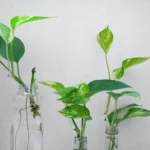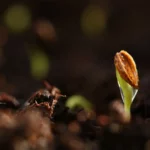Does your Pothos have some brown leaves? This is our guide on what is causing the problem and how you can solve it.
A Pothos plant with brown spots could have them as dots, chunks, or even entire leaves. But they might not be on the leaves. They can also show up on the stems.
Some common causes of brown spots on Pothos are direct sunlight, over/under fertilization, disease, pests, underwatering, and low humidity.
To solve these issues, you will need to water and feed it enough, keep it in a healthy environment, deal with pests and diseases quickly, and cut off the bad leaves.
Table of Contents
Brown Spots on Pothos
What it looks like
I know, on the surface, this might seem like kind of an obvious question. Surely brown spots are just spots that are brown? Well, yes, they certainly can look like that. However, round spots are not the only form of “brown spots” you might see on your Pothos.
Aside from the typical round spots, you might also find that chunks of the plant are brown. These chunks will not be round but rather look more like the leaves are half brown and half green.
You may also find that entire leaves have turned brown. Most of the time, what starts as a small brown dot can quickly turn into the whole leaf going brown.
Where you’ll find them
Some of the most common places to find brown spots on the Pothos is on the leaves. This could be in the centre but will more commonly be found on the tip. They can also start growing from the side of the leaves.
Occasionally, the brown spots won’t be on the leaves at all. But rather, on the stem. Basically, anywhere above the surface can have brown spots on them.
However, so long as your Pothos is not overrun with them, there is still a chance to fix the problem.
Causes of Brown Spots on Pothos
Direct Sunlight
The first cause of brown spots could be direct sunlight. All plants indeed need sun, and without it, there would be no photosynthesis, and your plant would quickly die. However, in the wild, your Pothos will live in a forest where other plants would filter out some of the sunlight.
Since Pothos is not adapted to bright, direct sunlight, there is a possibility of the plant being burnt. Direct sunlight, particularly from hot countries, can be too hot, which the Pothos might not be used to.
Fertilization
Another common cause of brown spots is fertilization. There are two ways that fertilization can give your Pothos brown spots.
Not getting enough or getting too much.
All plants need to be fertilized. In the wild, this happens when other plants die and bleed their nutrients into the soil. However, with houseplants, the plant parent (that’s you) will need to add something to ensure it’s being fed properly.
If you don’t fertilize it at all, your Pothos will not be able to absorb all of the nutrients it needs. However, if you fertilize it too much, the roots will become jammed, and it won’t absorb any of the nutrients within its soil.
Pests
Another common cause of brown spots is pests. This could include slugs, flies, mealy bugs, spider mites, or any other bug that could eat a Pothos.
When a bug decides to take a nibble out of your plant, it will take time for the plant to repair that area and bring it back to the way it used to be. The brown spots are formed to cover up the wound while it makes the appropriate repairs.
Tiny bugs can sometimes be the biggest enemies of the most giant plants.
Disease
Creepy crawlies aren’t the only living things you need to be wary of. The disease can also easily spread from plant to plant. And one of the consequences of illness is brown spots on your Pothos.
Often, when the disease enters your plant, your plant will throw everything it has at the problem to kill the infection and prevent it from spreading to the rest of the plant. This is sometimes successful.
However, while an area is fighting off the disease, it won’t be receiving any of the nutrients that keep your plant lovely and green.
Underwatering
All plants need water. Every cell in the plant is 80-90% water.
Without water, your plant will not be able to repair its cells. And this goes for any plant, not just the Pothos.
Since it’s the plant’s cells that provide the chlorophyll, which give them their distinct green colour, if the cells cannot repair, the cells that have died but have not been replaced won’t be green.
Instead, they will be the brown colour that you’re trying to get rid of.
Most of the time, not watering your plants can be due to forgetfulness. If the temperature is too high, the water can evaporate too quickly.
Humidity
Humidity refers to the amount of water in the air. The amount of humidity that will be best for your plant depends on what kind of plant it is. For the Pothos, between 20-30% humidity will be ideal.
Should there not be enough humidity, the water that you have given will just evaporate, and the plant may end up losing even more than it’s being given. Since this water is not in the plant, the chances of it developing brown spots will increase.
Solutions to Brown Spots on Pothos
Care for it
To care for your Pothos, you will need to make sure you water it enough and feed it enough (but not too much).
Generally speaking, about once a week will be enough to water your Pothos. However, you may need to water it more or less often. Don’t water it based on a schedule.
Instead, every day, feel the top of the soil to see how wet or dry it is. If it’s still damp, leave the watering and check again tomorrow. But, if the top of the soil feels dry, water it.
As for feeding, only do it during the spring and summer. Even then, once or twice a month should be more than enough.
The Environment
The environment that you’re keeping your Pothos in can also help to prevent brown spots. Try and keep the humidity between 20-30%. If this isn’t possible, you will need to water it more often.
Ensure that the temperature is between 27-32C. You can use a thermometer to keep up to date on the temperature of any room. Also, make sure your Pothos stays at a constant temperature. They don’t like it when you suddenly change the temperature.
Although Pothos likes bright light, bright but indirect is the best kind. Keep it in a room that doesn’t get direct sunlight, or cover the window with other plants to filter the light.
Keeping the pests away
The three best methods for keeping pests away are…
1. Soap and water. Mix dish soap with water and cover your plant with it. Any bugs will not be able to stick to the surface.
2. Bug Spray. Pretty self-explanatory. Spray the plant. Any bugs who go near it will die.
3. Rubbing alcohol. If a shot of tequila can put you to sleep, imagine what rubbing alcohol can do to something a fraction of the size of your finger.
With diseases, you could use a fungicide. This will attack fungal infections before they grow. If one plant is diseased, keep it away from all the others to stop it from spreading. ‘
Cut the leaves off
If there are only a couple of leaves with the problem, the quickest and most effective solution could just be to cut off the bad leaves.
By removing the problem straight away, your plant will not have to repair it. It can just focus on putting the hydration, energy, and nutrients the leaves still remaining. Many gardeners use pruning to keep their plants healthy.
What if you do nothing?
Some people make the mistake of thinking that if they just ignore the problem, the plant will repair itself, and the issue will go away over time. But I’m afraid this is not the case.
What is far more likely to happen is that the brown spots will continue growing until they have taken over every leaf on the plant.
A plant with brown spots left to fend for itself will stand a much higher chance of dying. If the environment or care is wrong, not changing it will cause more brown spots to form. And if the cause is bugs or infection, more bugs will come along, or the disease will grow even more. ‘
If your Pothos has brown spots, you will need to get it sorted.
Conclusion
And that is what to do when you find brown spots on your Pothos. Remember, if there is a bit of brown on the leaves of your Pothos plant, there is no need to panic.
You will need to work out what’s wrong with the plant and find the best solution to this problem. This article will have provided you with some ideas of what could be wrong.
Follow our advice, and your plant will be lovely and green in no time.



